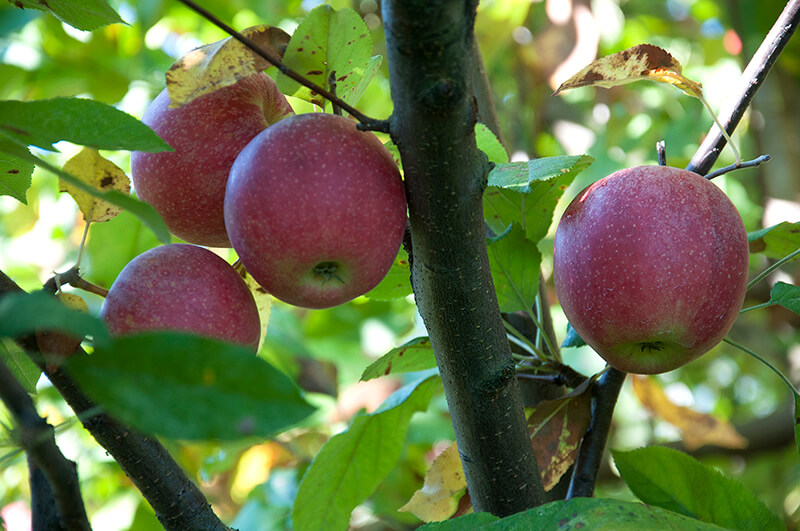October 11, 2017
Apple trees bear more fruit when surrounded by good neighbors
 Research led by Purdue University professor Peter Hirst shows that pollen from some apple trees may be better for pollinating high-value apples. (Purdue Agricultural Communication photo/Tom Campbell)
Download image
Research led by Purdue University professor Peter Hirst shows that pollen from some apple trees may be better for pollinating high-value apples. (Purdue Agricultural Communication photo/Tom Campbell)
Download image
WEST LAFAYETTE, Ind. – Apple growers want to get the most out of their high-value cultivars, and a Purdue University study shows they might want to focus on the types of apples they plant near those cash crops.
Since apple trees cannot self-pollinate, the pollen from other apple varieties is necessary for fruit to grow. Orchard owners often plant crab apple trees amongst high-value apples such as Honeycrisp, Gala and Fuji. Crab apples produce a lot of flowers and thus a lot of pollen for bees to spread around to the other trees.
“If you are growing some Honeycrisp, you want to plant something next to your Honeycrisp that bees will pick up and spread to your Honeycrisp and make good apples,” said Peter Hirst, a Purdue professor of horticulture and landscape architecture. “Growers will alternate plantings of different cultivars every few rows to promote cross-pollination, and they’ll sometimes put a crab apple tree in the middle of a row as well.”
Hirst and Khalil Jahed, a Purdue doctoral student, wondered if it mattered which type of apple pollinated high-value cultivars. To find out, they manually applied pollen from Red Delicious and Golden Delicious, and two types of crab apple, Ralph Shay and Malus floribunda, to Honeycrisp, Fuji and Gala. They put a net over the trees to keep the bees out, so they could control the pollen that was applied.
Their findings, published in the journal HortScience, showed that Honeycrisp pollinated with the Red Delicious variety doubled fruit set — the conversion of flowers into fruit — compared to Honeycrisp pollinated with the crab apple varieties.
In Honeycrisp, pollen tubes created by Red Delicious pollen reached on average 85 percent of the distance to the ovary, compared to 40 percent for pollen tubes from crab apple pollen. And fruit set with Red Delicious pollen was four times higher in the first year of the study, and eight times higher in the second, compared to crab apples.
“On Honeycrisp especially, the two crab apples we tried are not very effective at all. The pollen grows very slowly, and you end up with reduced fruit set as a consequence,” Hirst said.
The crab apples did better with Fuji and Gala but still didn’t match the effectiveness of Red Delicious pollen.
When pollen lands on the pistil of the flower, it must be recognized, and if it is compatible, the pollen will germinate and grow down the style to the ovary. Once fertilized, the ovule becomes a seed and the flower becomes a fruit.
Jahed collected flowers from pollinated trees each day for four days after pollination and measured pollen tube growth and fruit set. Overall, the Red Delicious was the best pollinizer, followed by Golden Delicious and then the crab apple varieties. Jahed said the experiment should lead apple growers to consider the design of their orchards to ensure that better pollinizers are planted near high-value crops.
“If they have a good pollinizer and a compatible pollinizer, the fruit quality and fruit set will be higher than with those that are not compatible,” Jahed said.
The research was part of Jahed’s master’s degree thesis, which he has completed. He and Hirst do not plan to continue studying the effectiveness of different pollinizers, but he hopes that others take up the research. They do plan to publish one final paper on pollination and fruit quality next year.
The United States Agency for International Development funded the study.
Contact: Brian Wallheimer, 765-532-0233, bwallhei@purdue.edu
Sources: Peter Hirst, 765-494-1323, hirst@purdue.edu
Khalil Jahed, 765-714-3521, kjahed@purdue.edu
ABSTRACT
Pollen Tube Set and Fruit Growth in Apple
Khalil R. Jahed and Peter M. Hirst
Pollination is an essential prerequisite for the production of many fruit and seed crops, including apple. In apple, successful fertilization requires pollen transfer to the stigma, pollen germination, and successful pollen tube growth resulting in fruit set. Precise selection of the most effective pollinizers for commercial orchards is not possible however, until these processes are more fully understood. The present study was undertaken to compare pollinizers in terms of pollen tube growth and fruit set. On trees of ‘Honeycrisp’, ‘Fuji’, and ‘Gala’ from which bees were excluded, flowers were hand-pollinated using pollen collected from crabapple (‘Ralph Shay’ or Malus floribunda), ‘Delicious’ and ‘Golden Delicious’. Flowers were harvested at one, two, three, and four days after pollination (DAP). Pollen source had a significant influence on pollen germination on the stigmatic surface, number of pollen tubes penetrating the stigma, distance of pollen tube growth down the style, and pollen tubes reaching the base of the style. In ‘Honeycrisp’ and ‘Gala’, ‘Golden Delicious’ pollen grew the fastest, followed by ‘Delicious’ and crabapple. Neither ‘Ralph Shay’ nor Malus floribunda were effective pollinizers for ‘Honeycrisp’ and resulted in low fruit set suggesting incompatibility may be involved. However, both these crabapples were effective pollinizers for ‘Fuji’ and ‘Gala’. These results indicate that pollen source can have a tremendous impact on pollen tube growth and fruit set. The physiological basis for these effects is not clear, but implications for pollinizer selection are obvious.
Agricultural Communications: (765) 494-8415;
Shari Finnell, Manager/Media Relations and Public Information, sfinnell@purdue.edu
Agriculture News Page

